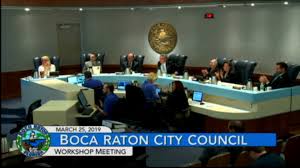PART 2:
How a city council can disregard citizen input to push through real estate development and more congestion
Ron Desantis’ vision of Florida is that the state would have no or few regulations. This has attracted predatory businesses, such as real estate developers, hedge funds, and private equity firms, even as Florida remains the top state in the nation for fraud. Under Desantis, it will only get worse.
Boca Raton may have the image of pink stucco walls and narrow streets lined with palm trees, but this postcard version of the city is not what its future will resemble.
Thanks to Governor Desantis’ vision of a Florida that is loose on regulations. These range from zoning to wearing COVID-19 prevention masks to allowing large corporations to run their internal human resources department and what lessons teachers can present to their students.
But for the residents of Boca Raton, “free” means allowing real estate developers to have a free hand in deciding how large a project can be and what special considerations the city must provide for the project to move smoothly and profitably.
To do this, the city relies on a few basic ways to minimize and sometimes eliminate public participation in significant construction developments in Boca Raton. 
These include the use of everything from state legislation to managing public meeting protocols:
Florida State Bill 102; This bill addresses affordable housing construction, but it also has some interesting provisions that make it impossible for any municipality in Florida to challenge a project. Specifically, the bill:
- “Preempts local governments’ requirements regarding zoning, density, and height to allow for streamlined development of affordable multifamily rental housing in commercial, industrial, and mixed-use zoned areas under certain circumstances.
- Removes a local government’s ability to approve affordable housing on residential parcels by bypassing state and local laws that may otherwise preclude such development while retaining such rights for commercial and industrial parcels.
- Removes provision in current law allowing local governments to impose rent control under certain emergency circumstances, preempting rent control ordinances entirely.
While the need for “affordable” housing carries political weight, the devil is in the details. In this case, the bill allows any residential project that provides 40% of its “affordable” housing space to be built to the highest limit of any other building within a one-mile radius. This could create a concrete forest of tall buildings.
Second, this law gives preferential treatment to projects that aim to provide “affordable” housing. One project slated for development to be built on the old IBM campus (an area near Clint Moore and Yamato Road), would offer three-bedroom apartments of 1,300 square feet for at least $4,000 per month. Surprisingly, there is no affordable housing in the new BRiC Project as of now. This is a question that vexes some long-time real estate observers.
Affordable housing is a thorny issue for the city and developers. One developer explained that under Bill 102, you have to adhere to all the setback rules, and that limits what you can build. As a result, developers cannot build 100 units per acre. With setbacks, you lose valuable building space and are height-restricted. The setbacks and units per acre rules also do not apply to downtown Boca, he said.
He concluded by saying that “the city is getting so built up that the only thing left to develop are commercial properties and golf course. This is what Boca has coming t it in the years ahead.”
Florida State Bill 620: Also known as the “Local Business Protection Act”; this bill allowed certain businesses to claim business damages from a county or municipality if the county or municipality enacts or amends certain ordinances or charter provisions that hurt the businesses’ profitability. The bill would have taken away some of the home rule powers of towns and cities that were affecting business operations, such as the closing times for bars, as well as zoning ordinances that affected development. The bill was widely considered a very pro-small business bill and it had the backing of the Florida League of Cities, one of the most powerful lobbying groups in Florida.
Publicly, the bill was presented as one that would prohibit puppy mills. But more importantly, it would have made a significant impact on local real estate development due to “onerous local regulations,” such as zoning restrictions.
Specifically, The Florida State Bill Analysis and Fiscal Impact Statement regarding Bill 620 states, “Currently, landowners have a cause of action under the Bert J. Harris Act (passed in 1995) to compensate them for the lost value of their land caused by certain local government actions; landowners have a cause of action for onerous local regulation in the form of exactions; and business landowners have a cause of action under eminent domain law for business damages related to a taking of real property. Similarly, this bill creates a cause of action for a business to sue a local government when the enactment or amendment of an ordinance or charter provision causes at least a 15 percent loss of profits to the business.”
Bill 620 would have given property owners recourse to contest city or town zoning restrictions it considered unfair or detrimental to their profitability. It would have allowed businesses to collect business damages and attorney fees if the business could prove a monetary loss “when an ordinance or a charter provision causes a business significant economic harm.” However, in a surprise move, Desantis vetoed the bill claiming it contained “broad and ambiguous language” that would lead to “unintended and unforeseen consequences.”
For a Republican who is supposed to be pro-small business, DeSantis’ veto surprised many Republicans. One real estate professional said DeSantis’ veto was strictly to keep the state’s municipalities behind him as he approached the election. “DeSantis just cares about his image and he will sell himself out for the vote, no matter what it is. His whole Republican Party caucus supported bill 620 and blindsided them by vetoing the bill, just to keep the municipalities happy, so they could keep and protect home rule,” he said.
Ex parte meetings: These are secret meetings outside the purview of the public between interested real estate developers and their agents and city officials. What is discussed and agreed upon is not disclosed to the public.
Stage-managed public meetings: One of the most frustrating things for Bocar residents who take the time to attend public zoning meetings is that they are not allowed to speak due to time constraints or, more commonly, the earlier speakers, who often represent developers, speak for too long. As a result, interested citizens get bored and leave the meeting.
A Case Study in Land Development and Profit
The Boca Raton Innovation Campus, known as BRiC, was developed in the late 1960s by IBM as its North American Research and Development facility. The world’s first personal computer was invented on this site.
Today, it’s a 1.7 million square foot office park and is the largest office complex in South Florida. Yet most residents will drive by this campus and not even know it’s there. It is bordered by Yamato Road, Spanish River Boulevard, and Broken Sound Boulevard, west of I-95 and about a half mile west of the Tri-rail Commuter line.
It is a prime attraction for developers because it is already developed and due to its location. This 120-acre site was purchased for about $179 by Crocker Partners (now called CP Partners) in 2018. In 2021, the Group sold BriC for $320 million to DRA Advisors “in one of South Florida’s biggest real estate investment deals this year,” according to the Commercial Observer. Why did the sales price of BRiC increase by $141 million in three years? The project received a preliminary OK to expand how the property would be developed vastly.
One of the significant concessions the new owners received was that it would require fewer parking spaces because it is a half-mile away from the Tri-Rail train station. The theory of planned mobility developments is that more people would be taking the train to work on the campus and would not need a car. That could be a stretch since commuting on public transportation in South Florida is uncommon. Still, the theory convinced zoning officials.
Under the new plan, the BRiC developers would only provide one parking space for every 1.75 square feet of finished space versus the current ordinance that calls for one parking space for every 500 square feet. Parking calculations can also be distorted by how many people will live in a residential unit in the BRiC development.
For instance, what if three adults live in an apartment, and each has their car? The variance only allows one parking space for that same unit.
Parking space code requirements are a way the city addresses congestion. Parking spaces are valuable property and are stated explicitly in the Boca Raton Engineering Design Standards Manual, according to whether the spaces are in office parking structures, and if they are in a parking lot, whether the incoming parking traffic is one-way or two-way. The type of building, location, and square footage determines the space required. As for the dimensions of the spaces themselves, the Manual says they should be 10 feet by 20 feet. (Page 26 of the Manual.) That’s a precious 200 square feet for every developer to sacrifice.

As a result of how this mandated valuable parking space can be used, a random look at Boca Planning & Zoning Board meeting minutes routinely shows that parking spaces are reduced or traded for other spaces on a property or an adjacent property to fit the variance*.
(The building code for parking spaces is particular in Boca Raton and covers almost every type of business, from mortuaries to restaurants to schools and doctors’ offices. See below for the Boca parking code requirements.*)
A Real Estate Developer Fable
There is an old tale about a scorpion who wanted to cross a river. Unable to swim, the scorpion asks a frog sitting on a nearby rock if he could ferry him across the river on his back.
 “I would do that for you, but how do I know you will not sting me and that I would not die?” the frog asked.
“I would do that for you, but how do I know you will not sting me and that I would not die?” the frog asked.
Perplexed, the scorpion replied: “I would not sting you since you are doing me a favor. And if I stung you, I would drown in the middle of the river. I also consider you my friend, so I would not harm you for doing me this great favor.”
Convinced by this logic and sincerity, the frog agrees. The scorpion climbs on the frog’s back, and the two start across the raging river. As they approach the far bank, the scorpion lifts his long tail and stings the frog. As the frog gasps for air, he asks the scorpion why he killed him despite his assurances that all would be well.
The scorpion looks the frog in the eyes and says: “It is my nature, and nothing I do can change it.”
Like the scorpion, the nation’s largest real estate developers have it in their nature to be repeat offenders of local zoning laws and other land use regulations that delay or hamper their projects. The evidence of this happens in every city and town where developers undertake a large, expensive project.
Unlike other industries, real estate developers also have access to significant tax credits that are not available to many other businesses. These tax credits include opportunity zones, historic tax credits, low-income housing tax credits (LIHTC), year 15 tax credits applied to LIHTC, new market tax credits, cost segregation, investment tax credits, production tax credits, energy/renewable energy tax credits, and brownfields tax credits. Tax credits help propel the industry. The other engine is looking for available land or buildings that a builder can profitably develop.
In South Florida—from West Palm Beach, Boynton Beach, Delray, Pompano Beach, and Miami– rampant real estate development is transforming towns with various residential, mixed-used, shopping, and commercial office spaces. To get more favorable considerations from local zoning regulations, developers often drive hard bargains against local zoning staff and city officials to get the most advantageous—and profitable—concessions.
As an example, a recent article by investigative reporter Jason Garcia in his blog “Seeking Rents” found that undisclosed lobbyists are persuading members of the Florida Legislature to “pass a controversial bill that would have made it much easier for real-estate developers to bulldoze older buildings in Miami Beach — a city famous for both its Art Deco architecture and its strict historic-preservation rules.”
These “opaque lobbying groups” with undisclosed donors are another way predatory real estate developers work in Desantis’ version of a state that distains regulation, accountability, and public disclosure. This is why Florida is the fraud capital of the U.S. and will get worse given the lack of ethics in the Florida legislature and the big money bulldozing local zoning codes. In Florida, bug money trumps quality of life. More congestion means higher taxes and lower property values for individual homeowners.
A 2018 study of cities around the Great Lakes in the Journal of Transport Geography by Jangik Jin and Oeter Rafferty found that noise, air pollution, stress, energy consumption, and wasting travel time…may lead to falling residential property values…Property values decreased in areas 5 to 15 miles from the central business district.
So, where does that leave Boca’s residents and those in other cities concerned about over-building?
Not in a good place. As long as elected officials in Florida disdain regulation and cater to special interests, residents will see a slight decrease in their quality of life, accompanied by an inability to hold them accountable.
*Boca Raton Parking Space Building Code Requirements, Sec. 28-1655. – Required off-street parking: Multi-dwelling units containing two or more living units: 1.75 motor vehicle parking spaces for a 1-bedroom unit, 2.0 motor vehicle parking spaces for a 2-bedroom unit, and 2.0 motor vehicle parking spaces for a 2-bedroom unit with den or a three or more bedroom unit, except that efficiency units shall require 1.5 motor vehicle parking spaces per unit; Places of public assembly: 1 motor vehicle parking space for every three seats, plus one motor vehicle parking space for every 25 square feet of additional, gross floor area provided for public assembly purposes. Business, professional, governmental, and research development offices: 1 motor vehicle parking space for each 200 square feet up to 4,000 square feet of gross floor area and one motor vehicle parking space for each 300 square feet in excess of 4,000 square feet.











